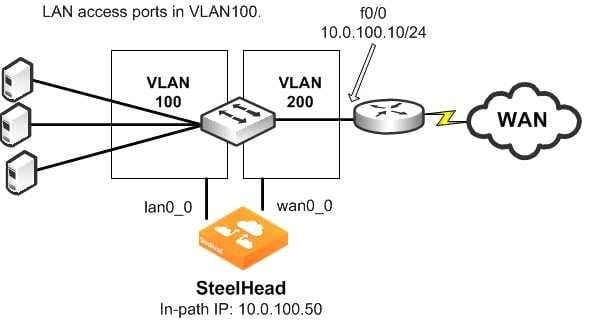Exam Details
Exam Code
:830-01Exam Name
:RCPE Certified Professional WAN OptimizationCertification
:Riverbed CertificationsVendor
:RiverbedTotal Questions
:402 Q&AsLast Updated
:
Riverbed Riverbed Certifications 830-01 Questions & Answers
-
Question 1:
What is the purpose of `Peer Affinity' on the Interceptor?
A. To keep similarly sized SteelHead models peering with each other.
B. To ensure load is distributed evenly throughout the cluster.
C. To maximize the benefits of SDR by maintaining SteelHead peering relationships.
D. To ensure asymmetrically routed connections are optimized.
E. To make sure cluster SteelHeads remain connected to the same Interceptor.
-
Question 2:
The SteelHead Out of Band splice (OOB) uses which addressing mode? Assume a default configuration.
A. Always correct addressing.
B. Depends on which addressing mode the first optimized connection uses.
C. Always transparent addressing.
D. Always destination transparency.
-
Question 3:
What is the first step in optimizing an SMTPS session?
A. An unencrypted SMTP connection is intercepted and optimized, before a START-TLS is issued.
B. START-TLS is issued immediately by the client and intercepted by the client side SteelHead.
C. SteelHeads do not currently support optimizing SMTPS sessions.
D. An SSL client HELLO is sent by the client and intercepted by the client side SteelHead.
-
Question 4:
A customer uses a single URL for a service that uses many servers with different certificates. What SSL options should be enabled to enhance performance?
A. Passive key derivation
B. SSL proxy support and SNI (Server name indication)
C. SSL advanced mode
D. Early start/late finish
-
Question 5:
Which deployment options are available to Virtual SteelHead on ESXi?
A. Physical In-path (with Riverbed bypass NIC)
B. Virtual In-path
C. Out-of-path
D. Server-side Out-of-Path
E. All of the above
-
Question 6:
A SteelHead is running RiOS v8.6 and has an inpath0_0 IP address of 192.168.1.10. It is later upgraded from v8.6 to v9.0. As part of an IT project, the inpath0_0 IP address is changed to 10.10.10.10 and the configuration saved. Some time passes and the administrator decides to revert to RiOS v 8.6. It hasn't been factory reset. The appliance boots and the Management Console User Interface is reachable, however, optimization no longer works. What has happened?
A. The web GUI SSL certificate is no longer trusted and the services require a restart.
B. The licenses are no longer valid and will need to be replaced and the services restarted.
C. It is not possible to revert to older versions of RiOS and the optimization service has stopped as a precaution.
D. The configuration has reverted to the one running under v8.6 and the inpath0_0 IP address is back to
192.168.1.10.
E. The configuration has been lost and the appliance is running factory default settings.
-
Question 7:
You plan to downgrade a SteelHead from RiOS v9.0.1 (Apr 17 2015) to 8.6.3 (Aug 7 2015). The appliance has not run v8.6.3 previously. Will this be successful?
A. No, downgrades are only permitted if the target version was previously installed.
B. No, it is not possible to downgrade RiOS.
C. Yes, the configuration will be migrated successfully during any downgrade.
D. Yes, v8.6.3 is a chronologically newer version.
-
Question 8:
The SteelHead REST API connectivity can be used for which of the following?
A. To synchronize layer 7 signatures and QoS configurations with the NetProfiler.
B. To export QoS and other statistics to the SteelCentral Controller for SteelHead (SCC).
C. To push secure transport configuration from the SCC to the SteelHeads NetProfiler.
D. To push topology information to the SteelHeads from the SCC for path selection.
E. To synchronize layer 7 signatures with the NetShark devices.
-
Question 9:
A SteelHead is deployed in a VLAN bridge. Which VLAN ID should be configured on the in-path interface to support this environment?

A. 1
B. 100
C. 200
D. No configuration is necessary as LAN and WAN interfaces are on access ports
E. It will require an in-path interface for each VLAN
-
Question 10:
You are using TCPdumps on the server-side SteelHead to troubleshoot an application connectivity issue.
The following filter is used on the TCPdump:
(host
and host ) or (host and host ) or (proto gre and ((ip[40:4] =
and
ip[44:4] =
) or (ip[40:4] = and ip[44:4] = )) or (port 7850) What part of the filter captures the traffic which the Interceptor has applied NAT to?
A. (ip[40:4] =
and ip[44:4] = ) B. (host
and host ) C. (proto gre and ((ip[40:4] =
and ip[44:4] = ) D. (host
and host )
Related Exams:
101-01
Riverbed Certified Solutions Associate201-01
Riverbed Certified Solutions Associate - Network Performance Management299-01
Riverbed Certified Solutions Professional - Network Performance Management499-01
Riverbed Certified Solutions Professional - Application Performance Management501-01
Riverbed Certified Solutions Associate - Hyper-converged Branch599-01
Riverbed Certified Solutions Professional - Storage Delivery Exam810-01
RCPE Certified Professional Network & Infrastructure Visibility830-01
RCPE Certified Professional WAN Optimization
Tips on How to Prepare for the Exams
Nowadays, the certification exams become more and more important and required by more and more enterprises when applying for a job. But how to prepare for the exam effectively? How to prepare for the exam in a short time with less efforts? How to get a ideal result and how to find the most reliable resources? Here on Vcedump.com, you will find all the answers. Vcedump.com provide not only Riverbed exam questions, answers and explanations but also complete assistance on your exam preparation and certification application. If you are confused on your 830-01 exam preparations and Riverbed certification application, do not hesitate to visit our Vcedump.com to find your solutions here.